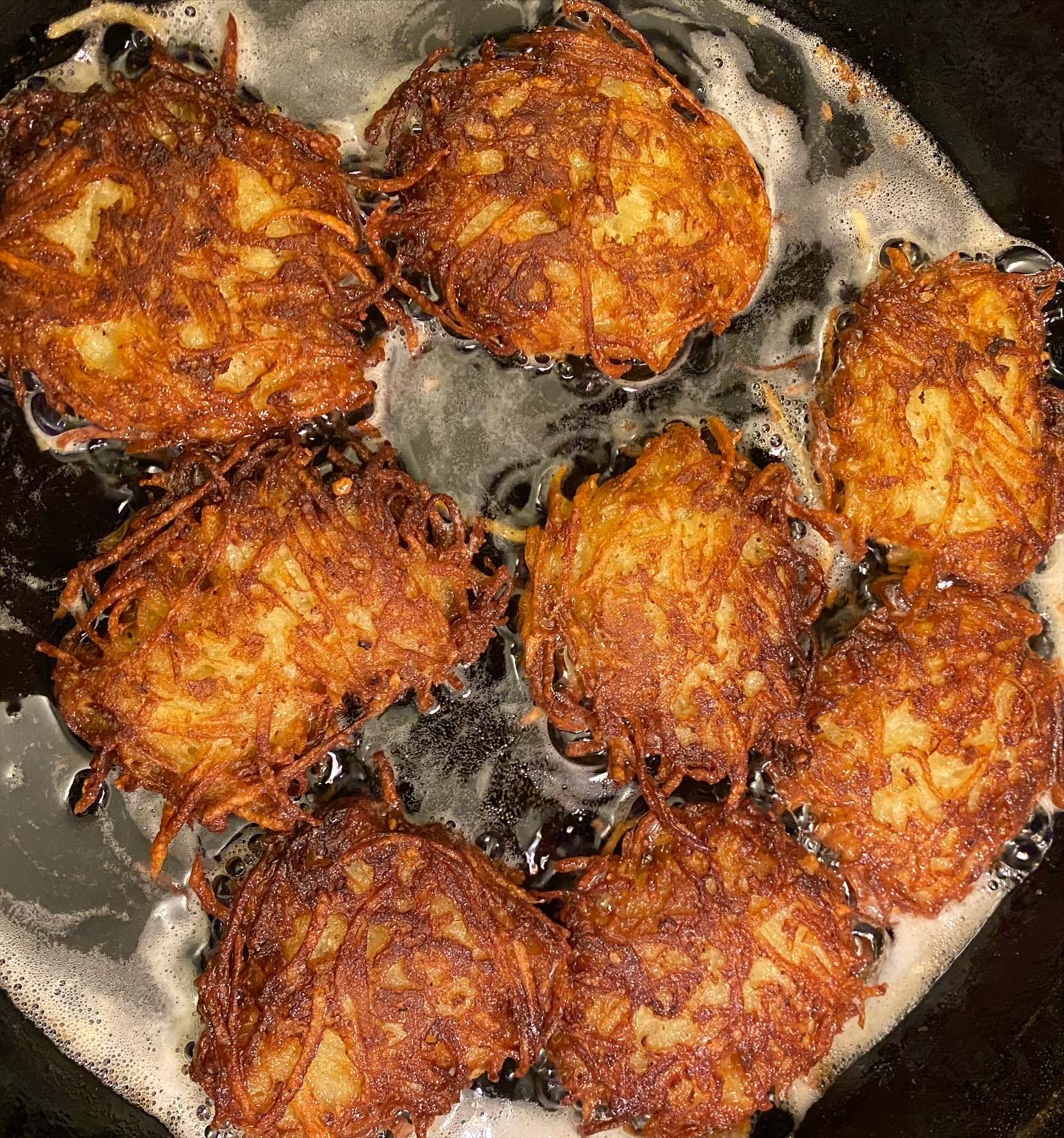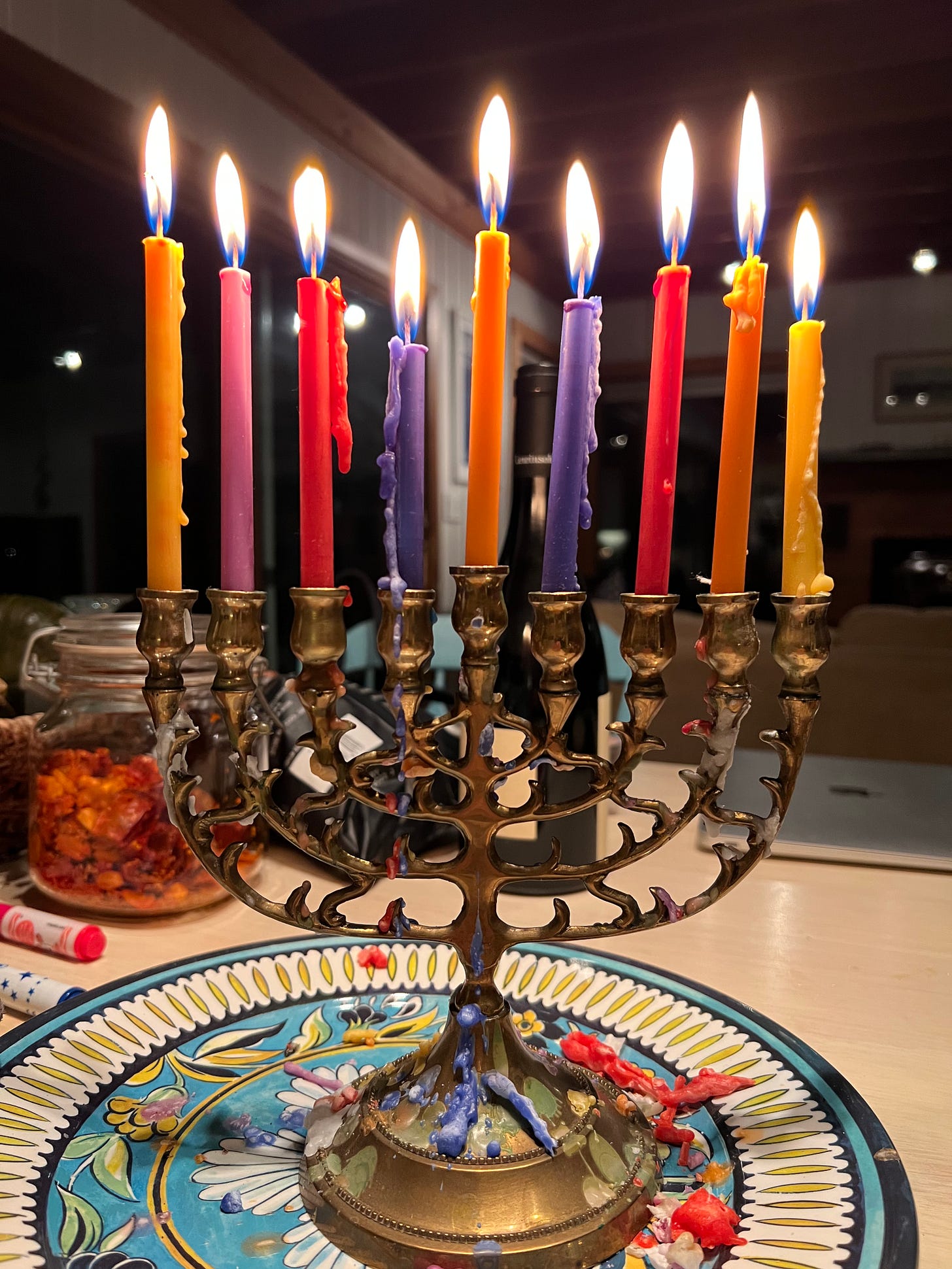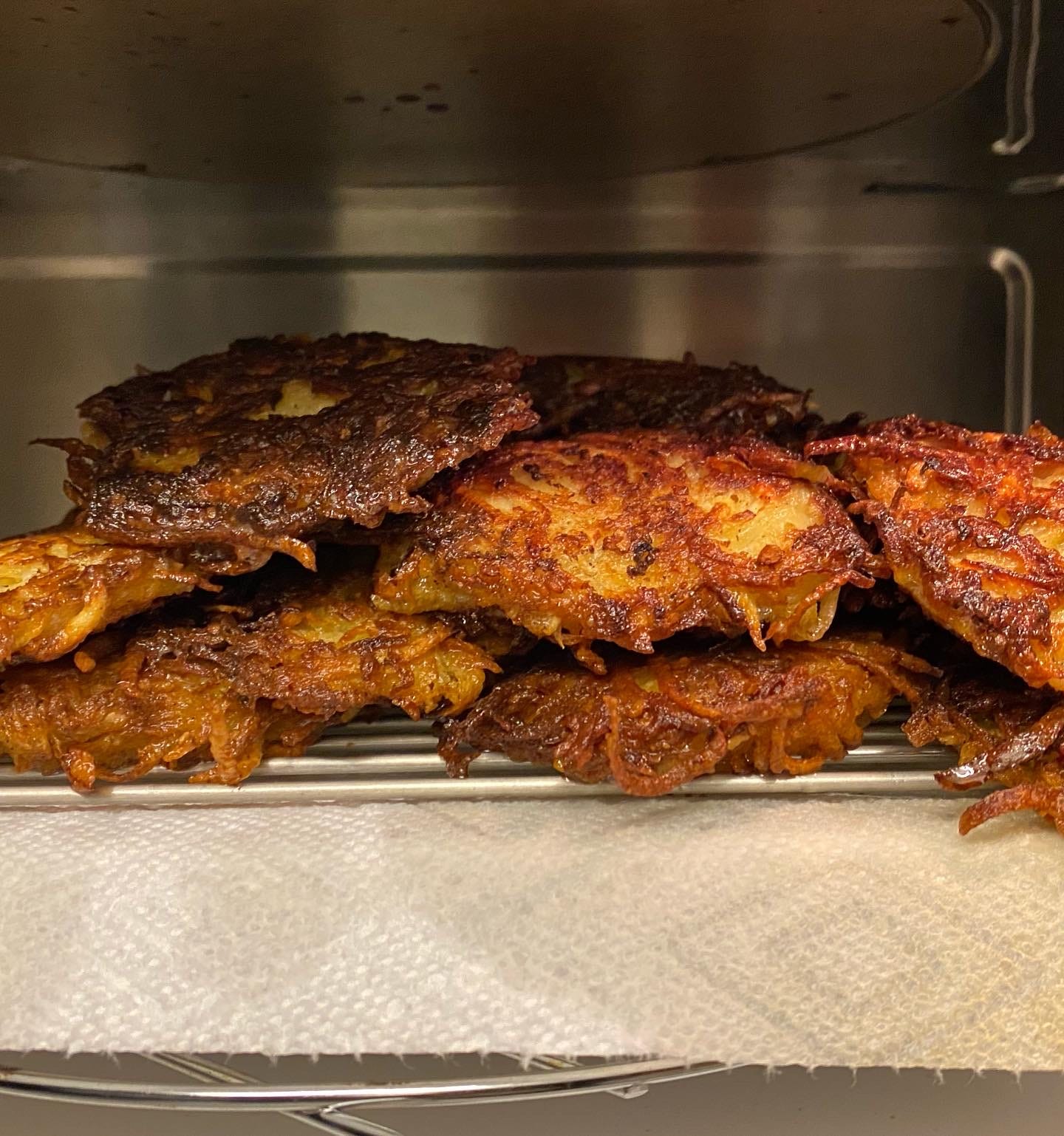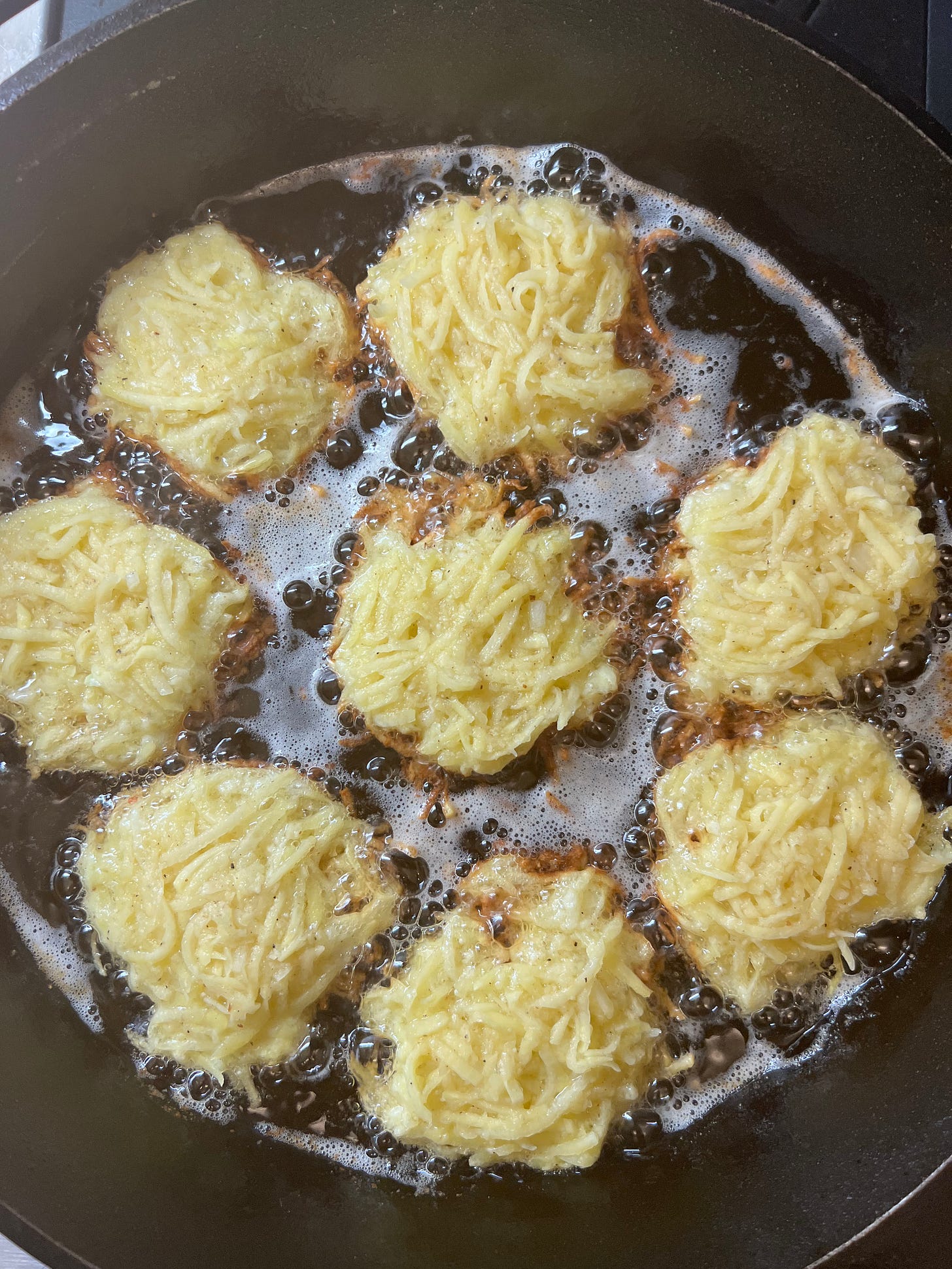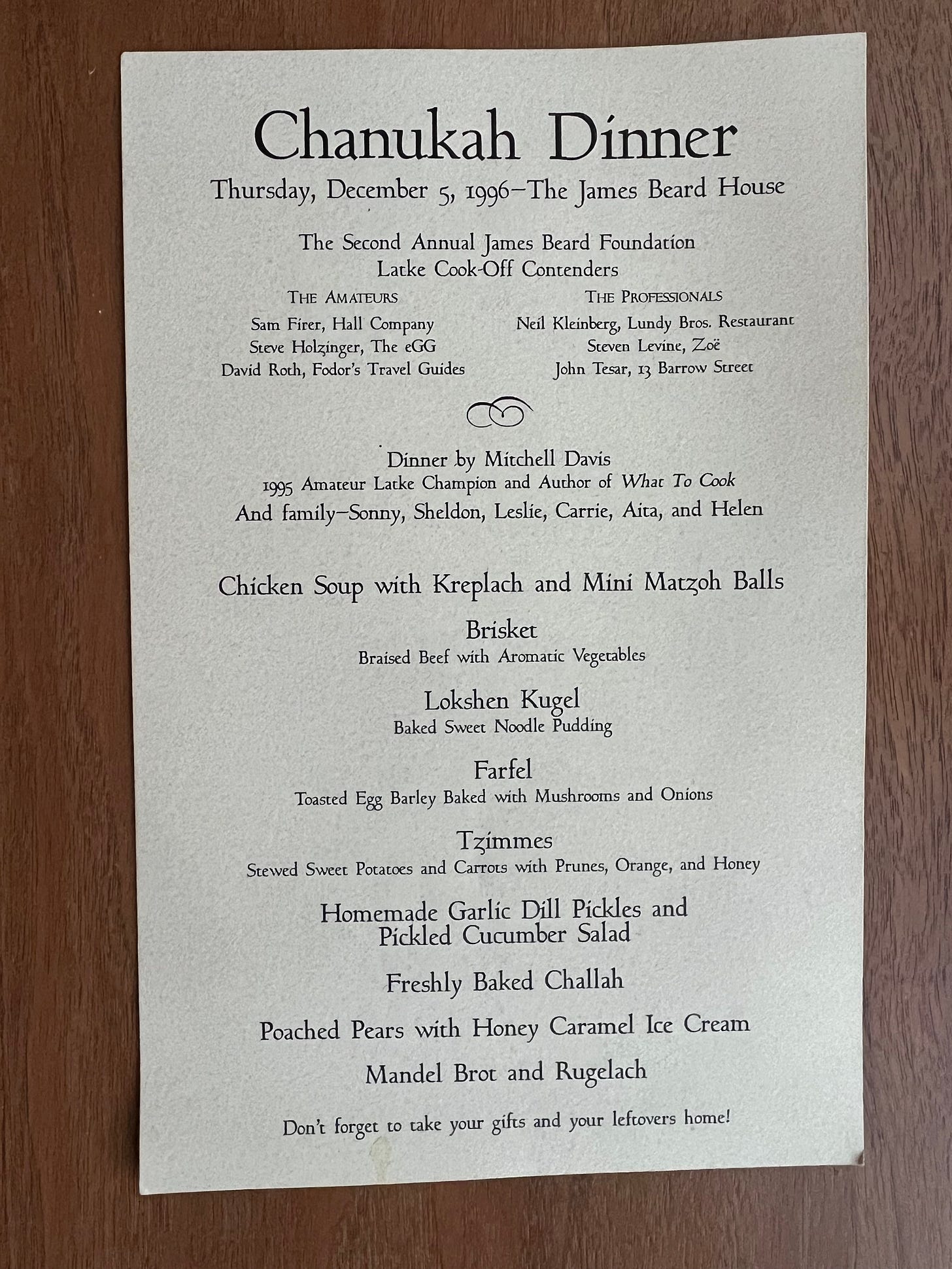Here we are, mid December. Holiday season. The year 2022 is drawing to a close. Hard to believe. I’m looking forward to the next few weeks of celebrations. What are you planning to cook? For Hanukah next week I’ll be making latkes, the same potato pancakes I make every year, so I’m reprinting the recipe for you here. If you are looking for holiday gift ideas, why not consider sending someone a paid subscription to Kitchen Sense? It’s perfect for anyone in your life who loves to cook and eat and who believes in supporting independent food writing.
Did you know the first latkes were thought to be made from cheese? It’s true (see Issue #27), but beside the point. An gratuitous segue. Anyone who has even the slightest interest in cheese won’t want to miss the new episode of my podcast What’s Burning because I’m talking with Bronwen Percival, the head cheese buyer for famed British purveyor of curds and whey Neal’s Yard. We only had an hour, but I could have talked with Bronwen for days. Bronwen is also co-author of Reinventing the Wheel, a very personal and informative book about the culture and cultures of raw-milk cheese. It’s a great conversation about history, terroir, and the complicated realities of craft food production in our modern era. Listen. What’s Burning is produced by the Galilee Culinary Institute and the Jewish National Fund USA.
It’s almost that time of year again to make latkes—that is, Hannukah. The time of year when we eat piles of potato pancakes slathered in applesauce and sour cream because God requires it of us. (OK, that’s a stretch.) The time when we say, “OMG! These are so delicious. Why do we wait for Hannukah? We ought to make latkes all year long.” But we never do.
Go ahead. Light your menorah. Spin your dreidel. But if you don’t make latkes, it isn’t a holiday #imho. Festival of Lights? Whatever. For us, it’s the festival of potato pancakes.
Having won the Amateur Category and the People’s Choice Award at the first-ever James Beard Foundation Latke Cook-off way back in 1995, I feel I have the right to a little swagger with my spatula.
That’s right, although I was nominated in 2003 for a James Beard Journalism Award for an extensive, two-part piece I wrote on Tokyo restaurants for the Art of Eating, the only James Beard Award I ever actually won was for my mother’s potato pancakes. I made Sondra (“Sonny”) Davis proud. More a ratio than a recipe—one onion for every two potatoes—the family latkes have the James Beard Foundation’s seal of approval.
The recipe is no secret. In fact, last year at this time I published it in this very newsletter, Issue #27. I’ve shared this recipe repeatedly ever since I took home the trophy from the Beard House. (It was actually a hand-written certificate.) The thing is, I don’t think most people want a different recipe for latkes every year. I, for one, want the latkes I love. Unlike some Jewish mothers, I don’t leave anything out of the recipe when I share it. From pancake to pancake, every latke has the same basic ingredients. The technique makes the difference. Many will think they can skip a step or two or change things around. Do so at your own risk.
Some important points to keep in mind:
Starchy, creamy potatoes are best. I like Yukon Golds.
Don’t skimp on the onions. They are what set these latkes apart.
Don’t skimp on the salt, either. Potatoes require a lot of salt.
As you work, the mixture will brown and get very wet. That’s okay. Just squeeze each pancake more and keep working until all of the later mixture is cooked.
Latkes take longer to cook than you think they will so start early. You have to keep regulating the heat of the pan to prevent too much browning before the center is cooked. Allow for enough time or you’ll be standing in the kitchen while your guests eat all the potato pancakes.
Latkes are best, some might say “only acceptable,” eaten out of the pan or as shortly after they are cooked as possible. This may sound like it contradicts the previous point, but I’m just emphasizing timing them right requires a delicate balance. I start frying about 25 minutes before guests arrive. If you want to serve the latkes all at once, keep the first ones warm on a wire rack in a 200°F. oven
RECIP: Sonny’s Specials: One-Onion-to-Two-Potatoes Latkes
4 Yukon Gold potatoes (about 2 ¼ pounds)
2 large white onions (about 1 pound)
2 large eggs, lightly beaten
1/4 cup matzo meal
2 to 3 teaspoons kosher salt
1/4 teaspoon freshly ground black pepper
About 3/4 cup peanut oil, for frying
Peel the potatoes. If using a food processor to grate the potatoes, cut them into large chunks that will fit into the feed tube. If preparing the peeled potatoes in advance, store them covered in cold water to prevent browning. Peel the onion, keeping the root end intact (to facilitate grating). Once you shred the potatoes, you must cook the latkes.
Line a large bowl with a clean dish towel. Using the large holes on a box grater or a food processor’s shredding disk, shred the potatoes into long strands. Place the shredded potatoes into the dish-towel-lined bowl. Roll up the towel to encase the potato and ring it out with all your might over the sink to extract as much liquid from as possible. Ring again. Open the towel and transfer the potatoes into the large bowl.
Use the medium holes of a box grater to grate the onions directly onto the shredded potatoes, holding the root end for a good grip. (Some claim the onion juice helps prevent the potatoes from browning, but I’m not so sure.) If any large pieces of onion fall into the bowl, remove them, chop finely, and return to the mix. Add the eggs, matzo meal, two teaspoons of the kosher salt, and freshly ground black pepper, and mix well.
Line a sheet pan with paper towel or brown paper and place a wire rack on top. Place the pan in an oven set to 200°F. When the oil is hot, pinch a small amount of the potato mixture to make a tiny test latke and fry until golden brown on both sides. Taste and adjust the seasoning, if necessary. Potatoes take more salt that you think and nothing is worse than an under-seasoned latke. Once satisfied with the seasoning, you can fry the latkes.
Depending on how large you like your latkes—we prefer ours on the small, thin side to increase the ratio of crispy edges—grab about a scant ¼ cup of the potato mixture and place it on your hand, palm side up, but closer to your fingers. Cover the mixture with your other hand and press your hands together to shape a flat-ish pancake, letting any juices run out through your fingers back into the bowl. Set this down in the hot oil and repeat to fill the pan. Do not crowd the latkes, or they will not brown properly. With the back of a fork, press down the centers of the pancakes in the pan to flatten slightly. You want to keep the scraggly edges of shredded potato so they will brown and crisp.
Latkes take longer to cook than you might think. And if the pan is too hot for the duration they will brown before they are cooked through. Remember these are raw potatoes. Give the first side about 10 minutes of medium to medium-high heat, until the whole side is nicely browned. Then flip them (I prefer to use a fork) and cook the second side, which takes less time, about 5 minutes.
When the second side is also nicely browned, transfer the latkes to the prepared wire rack in the oven to keep warm and crisp. Add more oil to the pan, if necessary, and allow it to heat up before adding the second and subsequent batches pancakes. Repeat, frying both sides until nicely browned. When all of the latkes are done, serve immediately with plenty of sour cream and apple sauce (homemade, of course, a recipe for which I provide in Issue #27, as well).
Memories…
After winning the James Beard Foundation Latke Cook-off in 1995, I was invited back the following year to cook the Hannukah dinner for the Second Annual Latke Cook-Off in 1996. I just came across a copy of the menu. It was a Jewish family feast.



